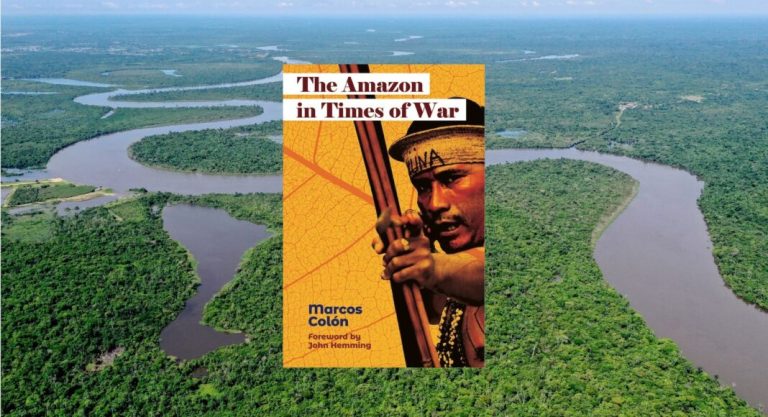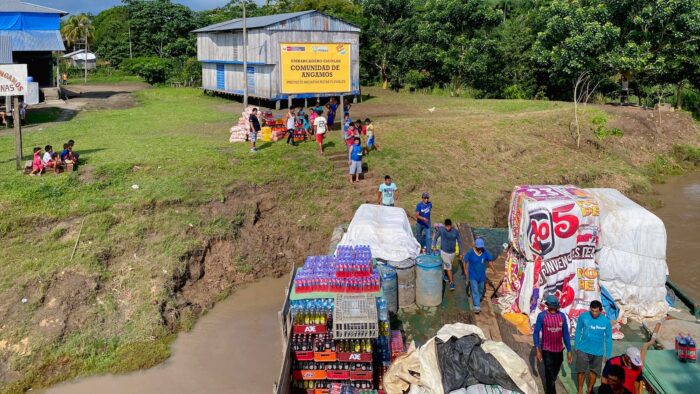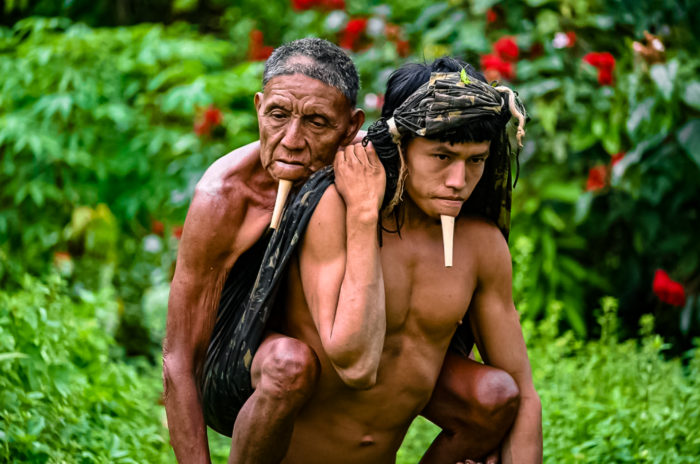
The Amazon in Times of War, an urgent call to action.
22 November, 2024New collection of essays on violence, devastation, and resilience.
‘The Amazon in Times of War’ is a powerful indictment of institutional violence against the Amazon and a tribute to the resilience and defiance of its Indigenous communities, as we look to them ‘to keep alive the hope of other possibilities for the Amazon’. What makes Colón’s book particularly distinctive are his first-hand accounts of visits to the Amazon.
This article was originally published by Latin America Bureau here. Sign up to Latin America Bureau’s newsletter for similar stories.
LAB’s most recent book The Amazon in Times of War, published in collaboration with Practical Action Publishing, is a collection of essays written by Marcos Colón that details the atrocities committed in the Amazon since Bolsonaro’s ascent to power in 2018. Acclaimed writer Scott Wallace describes the book as a ‘must-read for all who care about the future of the rainforest — and planet Earth.’
Marcos Colón is an academic, journalist and filmmaker with a clear commitment to studying the Amazon in all its intricacies, and The Amazon in Times of War is no exception. Writer and director of two feature-length documentaries addressing social, cultural and political concerns in the region, Colón is also editor and founder of Amazônia Latitude, a publication dedicated to multidisciplinary research on the Amazon, and Professor of Media and Indigenous Communities at Arizona State University.
His latest work, consisting of first-hand accounts of his experiences in the Amazon, in-depth research pieces, a photography exhibition and literary criticism, reads both as a powerful indictment of institutional violence against the Amazon and a tribute to the resilience and defiance of its Indigenous communities, as we look to them ‘to keep alive the hope of other possibilities for the Amazon.’
‘Environmental fascism is haunting the Amazon’
The first essays in the collection expose the horrors inflicted by the Bolsonaro government on the world’s largest tropical rainforest. As Colón writes, it was blatant from the beginning that Brazil’s ex-president was an individual who ‘does not speak for the landless, the leaseholders, or the small farmers, but has clearly made a commitment to the country’s agricultural capitalists.’ The commodification and exploitation of the Amazon for economic gain were at the top of his agenda, and no efforts were made to conceal this.
By radically reducing the power and scope of IBAMA (the Brazilian Institute of the Environment and Renewable Natural Resources) and FUNAI (the National Indigenous Peoples Foundation), while encouraging agribusiness and turning a blind eye to illegal practices such as logging and mining, Bolsonaro’s treatment of the region exemplifies what Colón refers to as ‘environmental fascism’: an anti-democratic regime that reproduces colonialism and ‘stands in direct opposition to the political struggle of its peoples.’
Environmental fascism has haunted the Amazon since 2018 and its catastrophic effects continue to linger like thick, unbreathable air that destroys all life around it; all one needs to do is read the Human Rights Watch report that documents the 2,195 hospitalisations attributed to respiratory illnesses in 2019 alone due to air pollution caused by deforestation-related activities.
Paired with these morbid statistics, what makes Colón’s book particularly distinctive are his first-hand accounts of visits to the Amazon.
2019 was a dire year for the Amazon, and Colón writes a damning essay on the forest fires that sparked international outcry and elevated ‘Brazil to the role of environmental villain.’ Whilst Indigenous leaders and activists struggled to prevent the further decimation of their land, Bolsonaro downplayed the fires, telling South American leaders that the ‘story that the Amazon is going up in flames is a lie and we must combat it with true numbers,’ despite figures revealing that more than 10,000 fires were recorded in the first 10 days of August 2019 alone, and deforestation rising by 34.5 per cent between July 2018 and July 2019.
Paired with these morbid statistics, what makes Colón’s book particularly distinctive are his first-hand accounts of visits to the Amazon. In an ‘anxiety-provoking’ trip to the triple-border town of Tabatinga in Brazil, he writes about the crime and violence endured by inhabitants due to drug trafficking and gang violence. He notes how there is a general air of impunity for criminals in Tabatinga, as ‘the state simply fails to pursue or punish the criminals involved in the murders, threats, and extortion.’
Colón reports the blatant disregard for violence when it is inflicted upon Amazonian bodies. Inhabitants of Tabatinga, as well as those living in many other towns and villages across the region, face constant threats of violence, whether to their own bodies or to their land. Between January and September of 2019 alone, there were 160 reports of land invasions in 153 Indigenous territories across 19 Brazilian states. Figures such as these appear throughout the book, painting a brutal but very real picture of what for many has become an ever-present risk.
‘In the Amazon, if COVID-19 doesn’t kill people, hunger will’
Part II of the book focuses on the COVID-19 pandemic and comprises six essays, the first of which discusses Colón’s research trip from Iquitos in Peru to Tabatinga in Brazil in March 2020. During his journey through the various towns and communities in the region, he documented the astronomical levels of food insecurity he witnessed, where many communities relied almost exclusively on exports to survive: ‘I could not help but notice how these Amazonian communities had changed… They had become almost entirely dependent on supplies that arrived via cargo boats, like the one I was travelling in.’ He refers to this as the ‘twin epidemic of hunger and the virus.’
Colón also took many photographs throughout his trip, which were later displayed in an exhibition titled Amazonia Hunger at Florida State University. Vibrant photographs adorn the book’s pages, from landscape shots that capture the serpentine quality of the Amazon’s riverine communities to close-ups of people carrying out daily activities, selling food at market, and washing their laundry in nearby rivers.

Deforestation and deregulation has made the treatment of diseases such as COVID-19 worse in an area where ‘public healthcare is at best precarious,’ and the rainforest ‘provides a health service of inestimable value when it is the source of quality water, food safety, and climate equilibrium.’ Deforestation and disease thus go hand-in-hand, which we see in the horrific case study of Brazil’s Yanomami People, which is examined in essay XI.
In a place where deforestation and disease have stripped many of the right to air, can we really continue to call it the lungs of the earth?
Citing the Cameroonian historian Achille Mbembe, Colón discusses the notion of an ‘unequal redistribution of vulnerability’ when referring to Indigenous peoples’ heightened vulnerability to COVID-19 and the paradox of this occurring in states with ‘the worst ratios of ICU beds and doctors to inhabitants.’ In Mbembe’s ‘On the Universal Right to Breathe’, from where the quote is extracted, he writes that ‘now is the time to expand our freedoms by instituting a universal right to breathe.’ In a place where deforestation and disease have stripped many of the right to air, can we really continue to call it the lungs of the earth?
Hope for the future
The third and final part of the book consists of six essays, followed by an epilogue written after Lula took office in 2022. While for many this marked the end of a fascist regime in the Amazon, Colón laments that ‘Lula…still fail[s] to understand that the war in defence of the Amazon is a war for human life itself.’
There is an interesting amalgamation here of hope and fatalism, perhaps best embodied by essay XIV and its title, ‘A Paradise Under Suspicion.’ Discussing representations of the Amazon in literature, Colón analyses the contemporary implications of metaphors such as ‘green hell’ and ‘paradise lost’, arguing that the latter has ‘acquired the condition of a cruel reality for today’s Amazonians.’
Colón also calls for an urgent global coalition ‘for the health and safety of Indigenous peoples and territories…to avoid a genocide.’ We as a global community are falling radically short of our duty of care to the Amazon. To put this into perspective, a report released by the Federal University of Rio de Janeiro estimates that by 2030 Brazil will have lost a further 200,000 km2 of forest.
Colón also calls for an urgent global coalition ‘for the health and safety of Indigenous peoples and territories…to avoid a genocide.’
In the midst of such startling denunciations, Colón does however offer a glimmer of hope. In the final essay before the epilogue, ‘Another Brazil is Possible’, we see the famous image of Tawy Zo’é, 24 with his father, Wahu Zó’é, 67, on his back as he takes him to receive his COVID-19 vaccination – an act of defiance against a president ‘who did everything possible to discourage vaccination of the population and public health protection measures for Indigenous people.’

The final lines read: ‘The Zo’é survive by virtue of their resilience, despite the government…They had their own, unique strategy, not only for survival but also for well-being. They could not be prevented from enjoying their lives in their own territories.’
Now more than ever must we listen to the voices of the Indigenous people who have been silenced by means of violence. The Amazon in Times of War is a powerful plea for us to do exactly this, as it will leave all who read it in a state of disillusionment and despair for the future of the Amazon if we continue on our current trajectory. In this sense, it is an urgent call to action to end the war on life. Marcos Colón’s voice fortifies the movement of global mobilisation for the Amazon region.
https://www.instagram.com/reel/DBGi9fcxMYG/
Follow Sounds and Colours: Facebook / Twitter / Instagram / Mixcloud / Soundcloud / Bandcamp
Subscribe to the Sounds and Colours Newsletter for regular updates, news and competitions bringing the best of Latin American culture direct to your Inbox.

